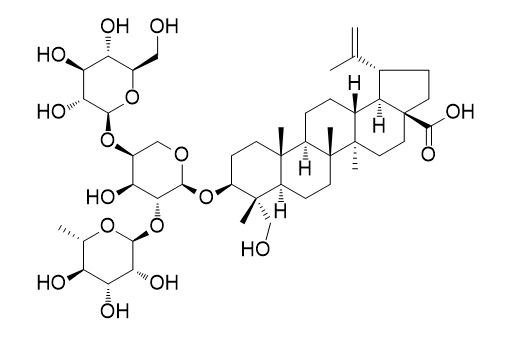Pulsatilla saponin D
Pulsatilla saponin D exhibits anticancer activities in various cancer types, it Inhibits autophagic flux and synergistically enhances the anticancer activity of chemotherapeutic agents against HeLa cells.Pulsatilla saponin D has strong haemolytic activity.
Inquire / Order:
manager@chemfaces.com
Technical Inquiries:
service@chemfaces.com
Tel:
+86-27-84237783
Fax:
+86-27-84254680
Address:
1 Building, No. 83, CheCheng Rd., Wuhan Economic and Technological Development Zone, Wuhan, Hubei 430056, PRC
Providing storage is as stated on the product vial and the vial is kept tightly sealed, the product can be stored for up to
24 months(2-8C).
Wherever possible, you should prepare and use solutions on the same day. However, if you need to make up stock solutions in advance, we recommend that you store the solution as aliquots in tightly sealed vials at -20C. Generally, these will be useable for up to two weeks. Before use, and prior to opening the vial we recommend that you allow your product to equilibrate to room temperature for at least 1 hour.
Need more advice on solubility, usage and handling? Please email to: service@chemfaces.com
The packaging of the product may have turned upside down during transportation, resulting in the natural compounds adhering to the neck or cap of the vial. take the vial out of its packaging and gently shake to let the compounds fall to the bottom of the vial. for liquid products, centrifuge at 200-500 RPM to gather the liquid at the bottom of the vial. try to avoid loss or contamination during handling.
Nutr Metab (Lond).2019, 16:31
Trop J Nat Prod Res, February2023, 7(2):2371-2381
Trop J Nat Prod Res2023, 7(12):5611-5615.
Naunyn Schmiedebergs Arch Pharmacol.2017, 390(10):1073-1083
Chinese Journal of Hospital Pharmacy2020, 40(7)
Plant Commun.2024, 5(10):101005.
Journal of Cluster Science2024, 35:635-656.
Clin Transl Oncol.2019, 10.1007
Asian Journal of Chemistry2018, 30(12):2699-2703
Heinrich Heine University Dusseldorf2021, 62203.
Related and Featured Products
J Nat Prod. 2018 Mar 23;81(3):465-474.
Cytotoxicity, Hemolytic Toxicity, and Mechanism of Action of Pulsatilla Saponin D and Its Synthetic Derivatives.[Pubmed:
29131631]
The strong hemolytic toxicity of Pulsatilla saponin D (1, HD50 6.3 μM) has hampered its clinical development as an injectable anticancer agent.
CONCLUSIONS:
To combat this challenge, 17 new derivatives of 1 with ring C, C-28, or C-3 modifications were synthesized and evaluated for cytotoxicity against several selected human tumor lines, as well as for hemolytic toxicity against rabbit erythrocytes. Structure-activity relationship (SAR) and structure-toxicity relationship (STR) correlations were also elucidated. Compared to the lead compound 1, the hemolytic activity of all 17 derivatives dropped dramatically. Notably, compound 14 exhibited significant cytotoxicity toward A549 human lung cancer cells (IC50 2.8 μM) in a dose-dependent manner without hemolytic toxicity (HD50 > 500 μM). Molecular studies indicated that 14 induced typical G1 cell cycle arrest and apoptosis in A549 cells, and Western blot assays suggested that both intrinsic and extrinsic apoptosis pathways were activated by 14.
CONCLUSIONS:
Collectively, compound 14 may merit further development as a potential anti-lung cancer agent.
Am J Chin Med. 2015;43(8):1657-70.
Pulsatilla Saponin D Inhibits Autophagic Flux and Synergistically Enhances the Anticancer Activity of Chemotherapeutic Agents Against HeLa Cells.[Pubmed:
26732119 ]
Pulsatilla saponin D (SB365), a saponin isolated from rhizoma of Pulsatilla chinensis (Bunge) Regel, exhibited anticancer activities in various cancer types.
METHODS AND RESULTS:
In the present study, we identified that SB365 was a potent inhibitor of autophagic flux in several cancer cell lines. SB365 induced a robust accumulation of autophagosomes as evidenced by monodansylaervarine (MDC) staining and increased protein levels of LC3-II. However, SB365 caused the accumulation of p62, a substrate that should be degraded through the autophagy-lysosomal pathway. These results indicated that SB365 was an inducer of autophagosome formation, but an inhibitor of autophagic flux. Interestingly, we found that SB365 synergistically enhanced the anticancer activity of chemotherapeutic agents against cervical cancer HeLa cells. Furthermore, our study demonstrated that SB365 increased the phosphorylation of ERK and inhibited the phosphorylation of mTOR and p70S6K, suggesting that their roles in the effects of SB365 on autophagy.
CONCLUSIONS:
These results suggest that SB365 could be a promising adjuvant anticancer agent.



